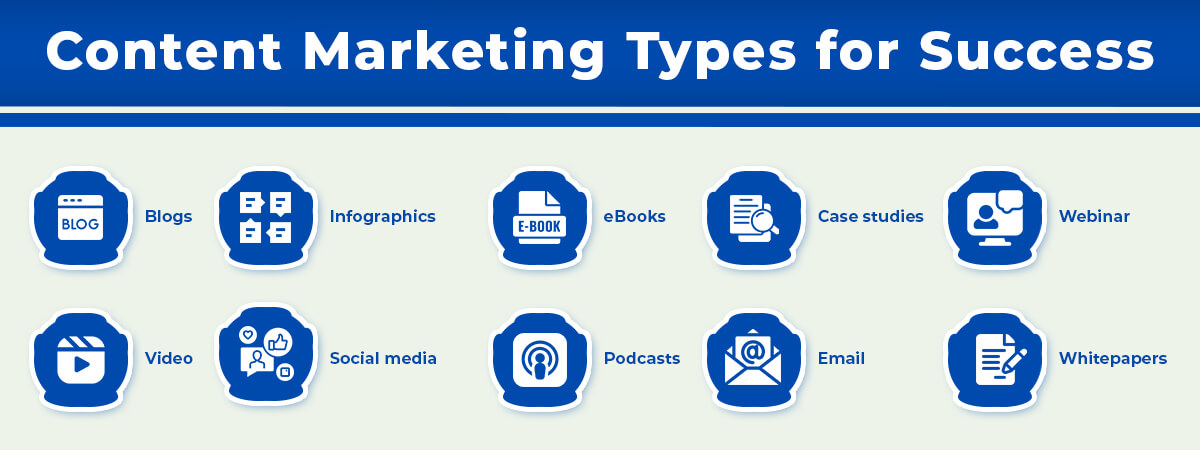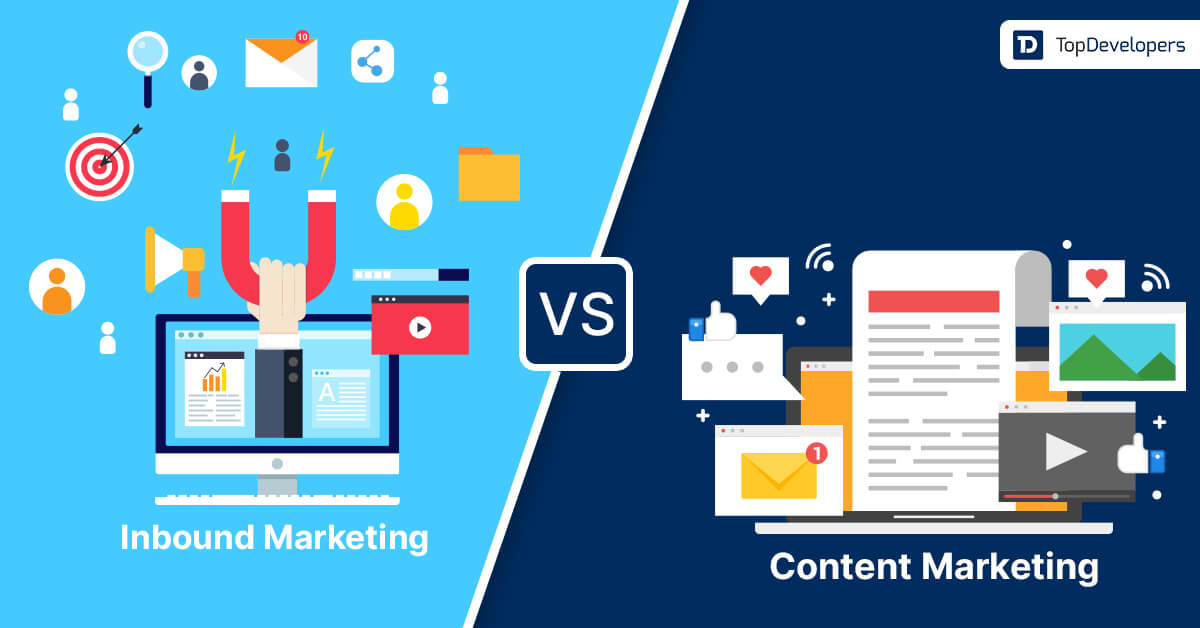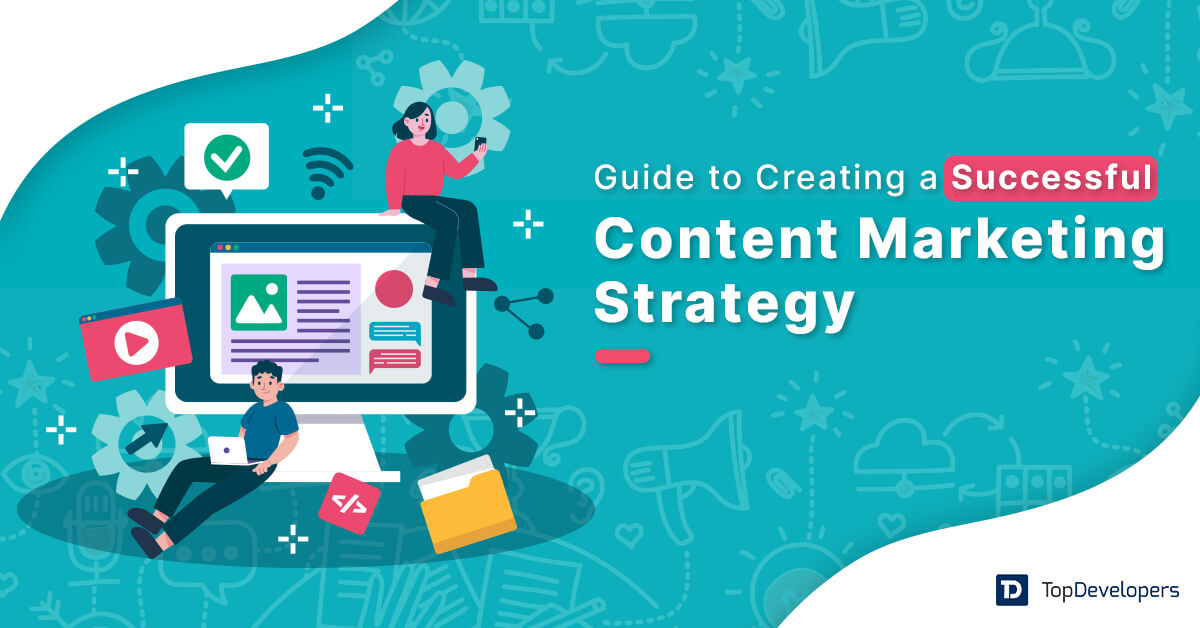
What’s the best way to educate your customers, offer a solution, engage and convert them?
The answer – your branded content.
Content is still the king of digital marketing. It provides value to your target audience, drives traffic, converts leads, and, most importantly, builds your authority in the niche.
But content without a strategy is like raw ingredients without a recipe card. You cannot cook something delicious to woo away your audience unless you know:
- How to use it?
- Which one to use?
- Where to use?
- When to use?
Content marketing is a strategy that weaves together all the content types to give voice and authority to your brand on digital platforms.
From blogs to infographics, ebooks, social media posts, and podcasts, marketers swear by these content types for unprecedented success.
In this blog, we will talk about 12 different types of content marketing that you can use to build your brand, increase online visibility and attract customers.
Table of Contents
Why Do You Need To Use Different Types Of Content Marketing?
People consume different types of content.
Some prefer blogs, some like social media posts, some are drawn to podcasts, and others like to delve into case studies and ebooks.
If you are producing only one or two types of content, you are only catering for a small group of people.
For example, if you concentrate only on producing blogs, you are targeting people who consume blogs.
So, you are missing out on those who would like case studies, ebooks, newsletters or even videos.
One must keep in mind that the target audience is scattered when it comes to content preferences.
That is why, to target all of them, you need to diversify the types of content you are producing.
When you create a content strategy that includes multiple content types, you:
- Reach a broader audience
- Have the scope to showcase brand authority in different formats
- Attract and engage customers in different ways
- Create multiple touchpoints for your business
- Put out your content across all digital platforms
This brings in potential customers in the long run and opens up the revenue stream for your business.
But it’s not necessary to use different types of content creation at once. You should choose the content types that suit your niche and needs.
Start with two to three content types and scale as you move forward.
10 Content Marketing Types For A Winning Content Strategy
Blogs
Blogs are one of the evergreen types of content marketing that produce visible results.
55% of content marketing agencies reported that short-form and long-form blogs perform better than other content formats.
A typical blog’s length falls somewhere between 1500-2500 words. Thus, it gives you enough space to focus on your target keywords, explain your topics better, and offer value to the audience.
The best thing about blogs is that they help you cater to your audience’s pain points and resolve their queries. Plus, blogs are the smartest way to address the problem statement and position your products/services as the best solution for it.
Customers, website traffic, and impressions love blogs that offer quality and value.
Moreover, blogs are a cost-effective way to regularly put fresh content on your website.
Video
YouTube has over 2.4 billion active users monthly. This means that billions of people consume video content.
YouTube doesn’t come as a priority content platform for marketers. And this is where they fail to tap into a larger audience pool.
Let’s face the reality – video content is more appealing to customers than text-based content. It is because of its convenience and engaging nature.
Moreover, TikTok (though banned in India) introduced the word to short video content format. These 20-second to 1-minute reels, or shorts, as YouTube, Meta and Instagram call them, have performed exceptionally well to captivate the audience.
Longer video content takes more time, effort, and resources to make. But you can initially start with reels and shorts to attract your audience. Plus, you can easily make reels with tools like Inshot, OpusClip, Canva, and Veed.io.
Videos can help you narrate your brand journey, show BTS, and share success stories. These touchpoints appeal to the emotions of your audience and build a strong relationship with them.
Infographics
What would you prefer – a long, boring paragraph or a short, crisp, visually appealing image?
The majority of the audience doesn’t consume your post or blog from its first to the last word. They tend to scan through your content. That is why we recommend a blog structure with high readability.
One of the ways to do it is to use infographics. Infographics present the content in short, crisp, and consumable bits.
It appeals to their eyes, attracts the audience to click, and even convinces them to share with their network. Thus, bringing more impressions, clicks, and engagement.
You can use infographics in your blogs and social media posts. However, make sure that all your infographics follow the same brand theme, colors, and design.
Social media
Social media is one of the must-have content types for content marketing. It is the best way to promote your products, connect, interact, and build relationships with your customers.
LinkedIn, Facebook, Instagram, YouTube, Twitter-X, TikTok are some of the popular social media platforms. But not every social media platform is made for you.
You need to find a suitable platform as per your niche. For example, businesses in the beauty and travel sectors are more popular on Instagram than on LinkedIn.
While IT companies prefer LinkedIn as their ideal platform to connect with their audience.
Also, the content you use should be aligned with your industry. Audiences of beauty and tourism would love reels and video content. On the contrary, clients looking for tech solutions would prefer case studies.
Our recommendation is to try out a few content formats and analyze the metrics. Sort out the posts that are garnering more likes and shares. Then accordingly create your strategy.
eBooks
eBooks come under gated or downloadable content. These are long form content pieces in the pdf format that focus on a detailed explanation of the topic.
eBooks are a hit among all types of content marketing because they generate leads.
When a website offers you an eBook, it asks for personal details, like your email address, name, designation, company name, and phone number. These details are the perfect way for the sales team to contact their lead (in this case you).
You are their lead because you showed interest in their eBook, probably looking for more in-depth information related to the services they are offering.
When your ebook delves into a niche topic or offers fresh perspectives, it can spark considerable interest in your business.
Podcasts
Podcasts are a new type of content marketing that helps you build your brand’s personality.
Plus, podcasts are accessible, as people can listen to them while traveling, walking, or even working.
Podcasts are a great way to share your experiences, stories and brand journey directly with your audience. Thus, helping you build stronger relationships with your audience.
To make your podcasts a hit, ensure that you offer valuable and entertaining content. Plus, you can even have guests and popular personalities on podcasts to boost their reach and virality.
Case studies
Claiming that your products/services are the best, doesn’t make them so. Every other brand calls itself the best among the lot.
So, how will you convince your audience that you are the one they need?
Case studies. They offer a deep dive into your portfolio, showcasing your successfully delivered projects. It informs the readers of the challenges of the project, your approach, the solution devised, and how you achieve the goals of the project.
These are mostly suitable for service-based companies, where they can portray how their services helped the client realize their business objectives.
Case studies are strong social proof that converts your potential customers more quickly than any other type of content marketing.
Getting your audience’s attention once might be easy. However, retaining them for the long term is difficult.
This is where emails come into the picture. Emails can help get your company name in your audience’s inbox.
Even if they don’t open it, they know you are always there. Your company’s name in the email notification is enough to remind them that you still exist.
If they open and interact with your content, that’s even better. To make it happen, ensure that your email copy is valuable, fun, and relevant.
For example, Nykaa sends emails about discount offers, upcoming sales and beauty tips from influencers.
An IT company sends newsletters about the latest tech developments, weekly research papers and tech memes for fun.
Find the type of content that will excite your audience and keep them waiting for your next email.
Webinar
Webinars aren’t so popular as compared to other types of content marketing. But performs exceptionally well in building relations with your audience at a personal level.
Whether you’re leveraging on-demand webinars to deliver value around the clock or hosting live sessions to forge personal connections, these online educational sessions offer an excellent opportunity to educate both current and potential customers, attract fresh leads, and establish your expertise in your industry.
To craft effective webinars, start by identifying areas of need. Perhaps there’s a recent regulation impacting your sector, stirring up numerous queries about its implementation. Maybe there’s a specific aspect of your product/service that customers find confusing. Alternatively, you might simply aim to share expert insights on a relevant subject.
Whatever the focus, ensure your webinars offer unique content that enriches participants’ understanding. By requiring an email address for registration, they also serve as a valuable tool for expanding your contact database.
Whitepapers
Do not confuse whitepapers with ebooks. Similar to ebooks, whitepapers are also lengthy but the content tone and style are very different.
Whitepapers include in-depth research content with data and statistics about your industry, audience and trends.
They offer the audience an insight into the pain points of your target audience and the solutions you offer to resolve them with credible sources.
It’s not easily consumable content because the content is very formal and business-centric. But you can always make it more appealing by using charts and graphics.
Whitepapers cater to a specific group of people. However, you should not overlook its importance as those who read and analyze it are very knowledgeable people.
Elevate Your Brand with a Strong Content Marketing Strategy
Picking the Right Types for Content Success!
There are different types of content marketing that you can use in your strategy to build your brand, narrate its story and attract your customers. Whichever type of content mix you use, always ensure that it:
- Offers value
- Promotes your services
- Is relevant to your niche and audience
- Caters to your audience’s pain points
- Easily shareable
- Fun and interactive
Initially start with easy content types like blogs and social media posts. Once you start to see traffic and impressions, scale your content marketing strategy to eBooks, webinars, podcasts and more.
Looking to hire a Content Marketing company? Find the best service providers on TopDevelopers.co.
 Avantika Shergil
| May 13, 2024
Avantika Shergil
| May 13, 2024
Avantika Shergil is a technology enthusiast and thought leader with deep expertise in software development and web technologies. With over 8 years of experience analyzing and evaluating cutting-edge digital solutions, Avantika has a knack for demystifying complex tech trends. Her insights into modern programming frameworks, system architecture, and web innovation have empowered businesses to make informed decisions in the ever-evolving tech landscape. Avantika is passionate about bridging the gap between technology and business strategy, helping businesses build customized software and website, and understand about different tools to leverage effectively for their ventures. Explore her work for a unique perspective on the future of digital innovation.






